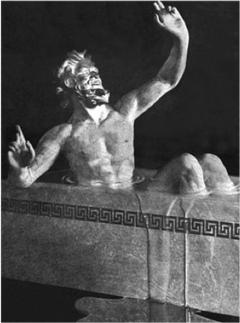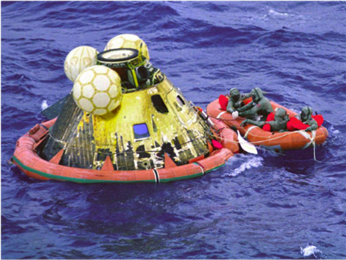-
WHAT IS NASA PHYSICS?
-
MODULES
-
Forces and Motion
-
Conservation of Momentum & Energy
-
Temperature and Heat
-
Fluids
-
Optics
-
Electromagnetic Spectrum
-
Modern Physics
-
Anticipation Guide 7
-
Intro to Modern Physics
-
Blackbody Radiation
-
The Ultraviolet Catastrophe
-
The Photoelectric Effect
-
Bohr's Atom
-
Spectra
-
Radioactive Decay
-
Special Relativity (SR)
-
Simultaneity
-
Distance and Time
-
General Relativity
-
May the Forces be with You
-
Modern Physics Notebook
-
Assessment Problems 7
-
-
Useful Things
-
-
SITE MAP
Fluids: Liquids and Gases
Equation
Fb = ρfVg
4.3
SCUBA Divers – Water and Air Pressure
Click image to Enlarge
x

SCUBA divers help ensure the safety of astronauts training to do various spacesuit maneuvers in the large Neutral Buoyancy Lab (NBL) at NASA Johnson Space Center in Houston, Texas. The reason for training underwater is that the astronaut spacesuit mass can be modified to mimic being weightless in space.
The SCUBA divers breathe compressed air (air under high pressure – much higher than that contained in the atmosphere at sea level). SCUBA divers – even those just swimming in pools – must always remember that they are breathing gas under high pressure. The gas pressure will equal the water pressure. A diver feels like she is taking the same size breath as when out of the water, BUT the diver actually has a LOT MORE air than that, but it’s compressed to the diver’s lung volume.
As a diver rises towards the surface the water pressure decreases (remember, water pressure is directly proportional to depth). The air in the lungs thus expands to a volume that can be much greater than the volume of the lungs. Breathing naturally – including regular exhaling – allows the excess air to be released. The rule for divers returning to the surface is to breathe normally – don’t hold your breath – and NEVER RISE FASTER THAN YOUR AIR BUBBLES.
Learn More
Pressure in Liquids
Buoyancy: Archimedes and Astronauts
 There is a famous story, which could be true, that the 22 year old Greek scientist Archimedes realized that the volume of water that overflowed a full bathtub equaled the volume of his body as he sat in the tub. He was so excited by his discovery that he jumped out of the bath and ran naked through the streets shouting Eureka – a Greek word meaning “I have discovered it.”
There is a famous story, which could be true, that the 22 year old Greek scientist Archimedes realized that the volume of water that overflowed a full bathtub equaled the volume of his body as he sat in the tub. He was so excited by his discovery that he jumped out of the bath and ran naked through the streets shouting Eureka – a Greek word meaning “I have discovered it.”
Archimedes Principle states that an object immersed in a fluid experiences an upward force equal to the weight of the fluid displaced by the object. Notice that the weight of the object doesn’t matter, it is the weight of the displaced fluid that equals the buoyant force. This can be written as:
buoyant force = fluid density x volume of fluid displaced x acceleration due to gravity Fb = ρfVg
With Fb = the upward or buoyant force (which is always upward, opposite gravity), ρf the density of the fluid, V the volume of displaced fluid, and g the acceleration of gravity.
Why do boats float?
 Archimedes Principle explains why objects float or sink. There are times when it’s crucial that objects float, like when a spacecraft containing astronauts splashdown in the ocean, as happened for the Mercury, Gemini, and Apollo space missions.
Archimedes Principle explains why objects float or sink. There are times when it’s crucial that objects float, like when a spacecraft containing astronauts splashdown in the ocean, as happened for the Mercury, Gemini, and Apollo space missions.
Left: Apollo landing recovery – Navy swimmers fasten a flotation collar around the capsule to provide more buoyancy. NASA image
Archimedes Principle states that an object in a fluid is buoyed up by a force equal to the weight of the fluid displaced. The buoyant force doesn’t depend on depth. If the density of an object is less than that of water, the object will float; if the overall density is greater than water, the object will sink.
Why do boats sink?
 If the air inside the hull of a vessel is replaced with water (e.g., the boat springs a leak or waves crash over the sides and fill the normally dry, air-filled compartments), the overall density of the vessel may exceed the density of water, causing the vessel to sink. That is what happened to NASA’s second manned space mission, the Liberty Bell 7 spacecraft in July 1961 when it’s hatch opened before the vehicle was stabilized for retrieval. Luckily, the one astronaut aboard, Virgil “Gus” Grissom, made it out and was rescued within a few minutes. But the accidentally opened hatch allowed seawater to flow in, making the spaceship more dense than it had been when it contained just air within its titanium hull. Starting with a mass of 1,286 kg, the flooded Liberty Bell weighed over 2,300 kg – at least 450 kg above the lifting capacity of the rescue helicopter - and sank to the bottom of the ocean, to a depth of approximately 5 km.
If the air inside the hull of a vessel is replaced with water (e.g., the boat springs a leak or waves crash over the sides and fill the normally dry, air-filled compartments), the overall density of the vessel may exceed the density of water, causing the vessel to sink. That is what happened to NASA’s second manned space mission, the Liberty Bell 7 spacecraft in July 1961 when it’s hatch opened before the vehicle was stabilized for retrieval. Luckily, the one astronaut aboard, Virgil “Gus” Grissom, made it out and was rescued within a few minutes. But the accidentally opened hatch allowed seawater to flow in, making the spaceship more dense than it had been when it contained just air within its titanium hull. Starting with a mass of 1,286 kg, the flooded Liberty Bell weighed over 2,300 kg – at least 450 kg above the lifting capacity of the rescue helicopter - and sank to the bottom of the ocean, to a depth of approximately 5 km.
Right: Image of astronaut Grissom being helped into his capsule before being launched into space. Image credit: NASA.
Amazingly, the Liberty Bell 7 capsule was recovered from the floor of the Atlantic Ocean on July 20, 1999 – the 30th anniversary of the Apollo 11 lunar landing. The Liberty Bell 7 is now on display at the Kansas Cosmosphere and Space Center.
© 2013 by Wheeling Jesuit University/Center for Educational Technologies®. 316 Washington Ave., Wheeling, WV 26003-6243. All rights reserved. Privacy Policy and Terms of Use.

